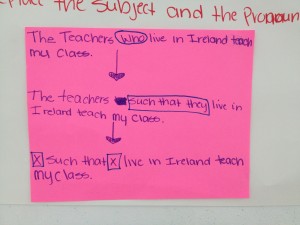How The Algebra Project Helps Math Make Sense

John O'Connor / StateImpact Florida
Sara Weinberg talks Miami Northwestern High School students through an Algebra Project assignment.
“This idea is to learn a language you have to talk it…you have to engage in it.”
That’s how Algebra Project founder Bob Moses described the principle underlying the program. Math is a language. And like any language, teachers need to help students translate the language into terms they understand.
But like the students learning algebra, it’s difficult to understand the process Moses described without watching students in action. So we sat in last week as the Algebra Project wrapped up orientation for its third group of students at Miami Northwestern High School.
“You can break down math into how you understand,” teacher Sara Weinberg told a group of students tentatively chatting about an assignment. “Break it into your language.”
Charts around the room provide guideposts. Relative pronouns become the mathematical statement, like “such that.” Relation words show what students are comparing, like how a student’s height compares to other members of his or her group.
Students walk over as a group to consult the charts and talk through the solution.
Here’s how the process works:
Students were assigned to small groups, and earlier in the week they measured the height of everyone in the group on a long strip of paper. They used that chart to write algebraic statements comparing height.
Students start with a plain statement: “Jesus’ height mark is higher than Chris’.”
Working together, they convert it to a statement like this, where HM stands in for height marks: “The HM which are above Chris.”
That sounds strange to the ear but it’s still easier to understand than the traditional language of algebra.

John O'Connor / StateImpact Florida
This chart shows students how to swap out plain language for mathematical language.
Then, students swap nouns for the variables and relative pronouns for mathematical statements: “The set of X such that X is above C”
Finally, students convert the statement entirely to symbols: {X|X>C}
“We just went from a sentence — ordinary people talk — to algebraic symbols,” Weinberg told the students after walking through the process.
This process lets students work forward or backward through a problem until they find language that’s familiar.
More than half — 52 percent — of Miami Northwestern students taking the state’s algebra end-of-course exam this spring scored a three or higher, considered a passing score. That’s up from 22 percent in spring 2012. The statewide passing rate increased to 66 percent from 58 percent over the same period.
